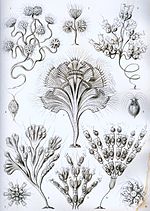Euglenids or euglenoids are one of the best-known groups of eukaryotic flagellates: single-celled organisms with flagella, or whip-like tails. They are...
19 KB (2,069 words) - 20:57, 2 November 2024
phagotrophy. Some unicellular species of green algae, many golden algae, euglenids, dinoflagellates, and other algae have become heterotrophs (also called...
92 KB (10,575 words) - 13:02, 4 November 2024
cells are flattened in shape, with a visible feeding apparatus. It is a euglenid, characterized by the presence of pellicle strips below the cell surface;...
2 KB (317 words) - 13:08, 10 May 2024
diatoms, brown algae), dinoflagellates, cryptophyta, haptophyta, and euglenids (the events may have begun in the Mesoproterozoic) while the first retarians...
174 KB (9,743 words) - 14:34, 29 October 2024
Anisonemidae is a small family of euglenid algae, with two accepted genera. It is the only family in the order Anisonemida. The family consists of single-celled...
3 KB (286 words) - 16:04, 29 April 2024
a clade of euglenids, single-celled eukaryotes or protists belonging to the phylum Euglenozoa. They are distinguished from other euglenids by active deformation...
5 KB (621 words) - 16:49, 28 April 2024
Moyeria is a genus of fossils interpreted as euglenids, a type of microbial eukaryotes characterized for their cells surrounded by a pellicle composed...
5 KB (484 words) - 02:53, 26 July 2024
Cercozoa—clade Rhizaria (unicellular) The euglenids—clade Excavata (unicellular) Except for the euglenids, which are found within the Excavata, all of...
110 KB (11,776 words) - 21:08, 24 October 2024
unicellular, mostly around 15–40 μm (0.00059–0.00157 in) in size, although some euglenids get up to 500 μm (0.020 in) long. Most euglenozoa have two flagella, which...
26 KB (1,770 words) - 17:22, 23 October 2024
chloroplasts in organisms that underwent secondary endosymbiosis, such as the euglenids and chlorarachniophytes. The chloroplasts come via endosymbiosis by engulfment...
6 KB (805 words) - 03:07, 28 November 2023
Euglenid Body Plan Dorsal flagellum Axoneme Paraflagellar rod Mastigonemes, "hairs" attached to flagellum Flagellar pocket vestibulum Feeding apparatus...
29 KB (3,064 words) - 22:11, 2 November 2024
pellicle includes a layer of closely packed vesicles called alveoli. In euglenids, the pellicle is formed from protein strips arranged spirally along the...
52 KB (5,212 words) - 05:40, 27 October 2024
Primarily, secondary chloroplasts derived from green algae are in the euglenids and chlorarachniophytes. They are also found in one lineage of dinoflagellates...
189 KB (19,141 words) - 15:05, 28 October 2024
place green algae and other unicellular photosynthetic organisms such as euglenids glycosome carries out glycolysis single-membrane compartment Some protozoa...
28 KB (2,365 words) - 02:59, 24 October 2024
Discoba: jakobids (F), kinetoplastids (bodonids, F/P, trypanosomatids, P), euglenids (F/A), some heteroloboseans (P/F/S) Metamonada: diplomonads (P/F), retortamonads...
13 KB (1,337 words) - 12:10, 5 November 2024
Spirocuta, distinguished by a greater number of pellicle strips than other euglenids. These strips allow the cells to actively deform their shape, a unique...
5 KB (556 words) - 16:18, 29 April 2024
alkaloid that is found in fire ant venom. This is the only known species of euglenids that is able to form toxic blooms that cause tangible losses to fish farms...
4 KB (403 words) - 04:52, 8 July 2024
first and only example of mixotrophic euglenids. The genus was defined as including flexible mixotrophic euglenids with two unequal flagella, a minimum...
16 KB (2,303 words) - 02:26, 20 May 2024
forward. In addition, like some other euglenids, their cells exhibit a certain movement known as metaboly or 'euglenid motion' characterized by extreme flexibility...
5 KB (522 words) - 20:58, 27 April 2024
endosymbiotic event that occurred between a phagotrophic eukaryovorous euglenid and a Pyramimonas-related green alga. The plastids of Euglena are unusual...
10 KB (1,009 words) - 19:19, 22 October 2024
studies in practical bacteriology. The euglenid genus Khawkinea is named in honor of Haffkine's early studies of euglenids, first published in French journals...
25 KB (2,770 words) - 17:17, 2 November 2024
animals and plants or fungi (e.g. slime molds and flagellated algae like euglenids), have been published under either or both of the ICN and the ICZN codes...
95 KB (9,835 words) - 20:56, 4 November 2024
Phototropic euglenids inherited their plastids from a close relative of Pyramimonas which was an endosymbiont inside phagotrophic eukaryovorous euglenids. "Pyramimonas"...
2 KB (92 words) - 17:06, 11 July 2023
membranes, reflecting a history of multiple engulfment. The chloroplasts of euglenids, chlorarachniophytes and a small group of dinoflagellates appear to be...
42 KB (4,163 words) - 13:26, 7 September 2024
that attach to protistan flagella. Flimsy hairs attach to the flagella of euglenid flagellates, while stiff hairs occur in stramenopile and cryptophyte protists...
5 KB (419 words) - 13:54, 12 June 2023
III intron is a class of introns found in mRNA genes of chloroplasts in euglenid protists. They have a conventional group II-type dVI with a bulged adenosine...
4 KB (543 words) - 14:27, 5 November 2021
them. The chloroplasts in dinoflagellates of the genus Lepidodinium, euglenids and chlorarachniophytes were acquired from ingested endosymbiont green...
27 KB (2,663 words) - 17:15, 26 October 2024
chloroplast is a plastid which contains chlorophyll B, as in green algae, some euglenids, and the land plants. H.S. Yoon; R.A. Andersen; S.M. Boo; D. Bhattacharya...
33 KB (3,303 words) - 12:05, 31 August 2024
origin of this dual naming system is because of the history of protists. Euglenids have been treated as both algae and protozoans, which are governed by...
4 KB (395 words) - 16:07, 29 April 2024

























